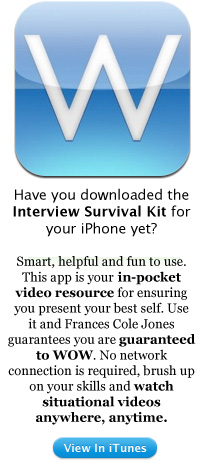With more and more companies using the latest technology to find efficiencies in the recession, far-flung, “virtual” teams are becoming a part of many people’s work day., Therefore, I thought it was important to put together a top ten list of the most effective strategies for building, and maintaining, virtual team spirit—the spirit that builds trust, and encourages concrete results.
 1. Gather ‘round and go around
1. Gather ‘round and go around
We all know a picture is worth a thousand words so sharing pictures of team members is critical. Still more valuable is posting them on a one-sheet that’s a diagram of a clock face so members can say, “This is Ellen at 9 o’clock” thereby saving team members from having to scroll frantically through members’ pictures to remind themselves who’s speaking. This method counteracts disembodied voices on conference calls, and helps prevent “hiding” by participants.
2. One may be lonely, but it’s also the most effective number
On conference calls, if even one member of the team is in an office by his or herself, the remainder of the team needs to be separated from one another—even if they are in the same offices. This can seem like a pain to arrange, but anything else leaves the person working solofeeling still more isolated.
3. Sort through the holidays and ho-downs
If your team is international, building trust is about more than the time zone in which they’re located. Many countries celebrate different holidays, start work later, stay longer, etc. Additionally, some Asian countries have a policy of working on Saturdays that needs to be acknowledged and factored in at the outset. If you work this out in advance, you can even gain efficiency by working out the ideal schedule for “handover” of work.
4. Establish your “note-passing” policy
The same way it is distracting to a teacher and fellow students to have two people passing notes in class, it is distracting for two people to be IM’ing or emailing during a call. (And please don’t think others don’t notice. They do. My recommendation is that the only use of IM or email during a call would be to alert others to a technical breakdown.
5. Version 2. WHAT?
Few things are more maddening than scrolling through six versions of a document—each with a very slightly different draft name– trying to figure out who touched it last. My suggestion is begin with V.01, for version 1, and move on from there. This will, at least, take you through V.99 before you need to recalibrate. A great add-on is to adopt the protocol that “whole numbered versions” (e.g. V2.0) are “client-ready”, whereas fractional numbers (e.g. V0.23) are still works in progress.
6. Show Your Work
Should you make any change in a document that has the potential to bemisconstrued (i.e. anything beyond fixing typos/grammar/clarity) include a note explaining the rationale behind the change. This will either mollify team members or give you a jumping off place for discussion—rather than dissension- at your next meeting.
7. Standardize Your Team Turnaround Time or State Your “By When”
People wait far more patiently if they know by when something is going to happen—this is the reason most mass transit has begun incorporating announcements regarding where the next bus/train is, and when it can be expected. Have a stated turnaround time for your team. If that deadline is going to be missed, state by when you will be in touch.
8. Silence is not (necessarily) golden
Too often a question is asked and falls into silence, leaving the questioner wondering, “Are they quiet because they agree with me, disagree with me, are not paying attention to me?” Establish your silence policy—i.e. silence signals disagreement/disagreement; or each question must be met with a round of polling – explicit yes’s or no’s from all participants.
9. “Don’t you put that sheep on my head”
Different countries have different idiomatic expressions—the above was a striking reinterpretation of “Don’t try to pull the wool over my eyes.” Alternatively, ideas we “run up the flagpole” or consider “a home run,” may be similarly misconstrued by listeners in different countries. Clarify and/or (for fun) keep a running list everyone can learn from. (nb: Poland uses “I wouldn’t bet my head on that” for “I wouldn’t bet my life”; and one of my favorites is the Italian equivalent of “You can’t have your cake and eat it, too “: “You can’t have a full bottle of wine and a drunk wife.”)
10. Mix it Up
With far-flung teams, there is no opportunity to blow off steam together after work—yet the interpersonal connections forged during these get-togethers is vital to creating camaraderie. What to do? Arrange a weekly test-drive (and subsequent commentary on) the “libation of your nation” — beer, chai, sake, double espresso, or create a signature drink peculiar to your team alone.
 Follow the lead of the CEO. Yes, it might feel outdated, but he or she is the one writing your check. If he or she is in asuit, you need to be in a suit. If he or she prefers adress shirts and slacks, plan to prefer them, too; ditto, T shirts and jeans, etc.
Follow the lead of the CEO. Yes, it might feel outdated, but he or she is the one writing your check. If he or she is in asuit, you need to be in a suit. If he or she prefers adress shirts and slacks, plan to prefer them, too; ditto, T shirts and jeans, etc.






















